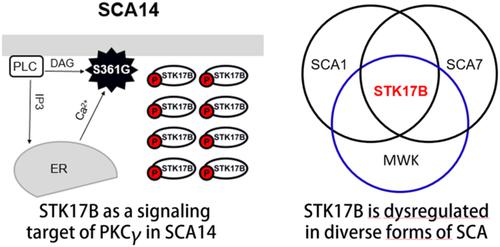当前位置:
X-MOL 学术
›
Eur. J. Nerosci.
›
论文详情
Our official English website, www.x-mol.net, welcomes your feedback! (Note: you will need to create a separate account there.)
Serine/threonine kinase 17b (STK17B) signalling regulates Purkinje cell dendritic development and is altered in multiple spinocerebellar ataxias
European Journal of Neroscience ( IF 3.4 ) Pub Date : 2021-09-18 , DOI: 10.1111/ejn.15465 Qin‐Wei Wu 1 , Josef P. Kapfhammer 1
European Journal of Neroscience ( IF 3.4 ) Pub Date : 2021-09-18 , DOI: 10.1111/ejn.15465 Qin‐Wei Wu 1 , Josef P. Kapfhammer 1
Affiliation

|
Serine/threonine kinase 17b (STK17B, also known as DRAK2) is known to be a downstream effector of protein kinase C (PKC) in the immune system, in particular T lymphocytes. PKC activity also plays a critical role for dendritic development and synaptic maturation and plasticity in cerebellar Purkinje cells. We present evidence that STK17B is strongly expressed in mouse cerebellar Purkinje cells starting in the early postnatal period and remaining highly expressed throughout adult stages and that STK17B is a target of PKC phosphorylation in the cerebellum. STK17B overexpression potentiates the morphological changes of Purkinje cells seen after PKC activation, suggesting that it is a downstream effector of PKC. A phosphorylation mimetic STK17B variant induced a marked reduction of Purkinje cell dendritic tree size, whereas the inhibition of STK17B with the novel compound 16 (Cpd16) could partially rescue the morphological changes of the Purkinje cell dendritic tree after PKC activation. These findings show that STK17B signalling is an important downstream effector of PKC activation in Purkinje cells. Furthermore, STK17B was identified as a molecule being transcriptionally downregulated in mouse models of SCA1, SCA7, SCA14 and SCA41. The reduced expression of STK17B in these mouse models might protect Purkinje cell dendrites from the negative effects of overactivated PKC signalling. Our findings provide new insights in the role of STK17B for Purkinje cell dendritic development and the pathology of SCAs.
中文翻译:

丝氨酸/苏氨酸激酶 17b (STK17B) 信号调节浦肯野细胞树突发育,并在多发性脊髓小脑共济失调中发生改变
丝氨酸/苏氨酸激酶 17b(STK17B,也称为 DRAK2)是免疫系统中蛋白激酶 C(PKC)的下游效应子,尤其是 T 淋巴细胞。PKC 活性对小脑浦肯野细胞的树突发育和突触成熟和可塑性也起着关键作用。我们提供的证据表明,STK17B 在出生后早期开始在小鼠小脑浦肯野细胞中强烈表达,并在整个成年阶段保持高度表达,并且 STK17B 是小脑中 PKC 磷酸化的目标。STK17B 过表达增强了 PKC 激活后浦肯野细胞的形态变化,表明它是 PKC 的下游效应子。磷酸化模拟 STK17B 变体诱导浦肯野细胞树突树大小显着减少,而用新型化合物 16 (Cpd16) 抑制 STK17B 可以部分挽救 PKC 激活后浦肯野细胞树突树的形态变化。这些发现表明 STK17B 信号是浦肯野细胞中 PKC 激活的重要下游效应器。此外,STK17B 被鉴定为在 SCA1、SCA7、SCA14 和 SCA41 的小鼠模型中转录下调的分子。这些小鼠模型中 STK17B 的表达降低可能会保护浦肯野细胞树突免受过度激活的 PKC 信号传导的负面影响。我们的研究结果为 STK17B 在浦肯野细胞树突发育和 SCA 病理学中的作用提供了新的见解。这些发现表明 STK17B 信号是浦肯野细胞中 PKC 激活的重要下游效应器。此外,STK17B 被鉴定为在 SCA1、SCA7、SCA14 和 SCA41 的小鼠模型中转录下调的分子。这些小鼠模型中 STK17B 的表达降低可能会保护浦肯野细胞树突免受过度激活的 PKC 信号传导的负面影响。我们的发现为 STK17B 在浦肯野细胞树突发育和 SCA 病理学中的作用提供了新的见解。这些发现表明 STK17B 信号是浦肯野细胞中 PKC 激活的重要下游效应器。此外,STK17B 被鉴定为在 SCA1、SCA7、SCA14 和 SCA41 的小鼠模型中转录下调的分子。这些小鼠模型中 STK17B 的表达降低可能会保护浦肯野细胞树突免受过度激活的 PKC 信号传导的负面影响。我们的发现为 STK17B 在浦肯野细胞树突发育和 SCA 病理学中的作用提供了新的见解。这些小鼠模型中 STK17B 的表达降低可能会保护浦肯野细胞树突免受过度激活的 PKC 信号传导的负面影响。我们的研究结果为 STK17B 在浦肯野细胞树突发育和 SCA 病理学中的作用提供了新的见解。这些小鼠模型中 STK17B 的表达降低可能会保护浦肯野细胞树突免受过度激活的 PKC 信号传导的负面影响。我们的研究结果为 STK17B 在浦肯野细胞树突发育和 SCA 病理学中的作用提供了新的见解。
更新日期:2021-10-20
中文翻译:

丝氨酸/苏氨酸激酶 17b (STK17B) 信号调节浦肯野细胞树突发育,并在多发性脊髓小脑共济失调中发生改变
丝氨酸/苏氨酸激酶 17b(STK17B,也称为 DRAK2)是免疫系统中蛋白激酶 C(PKC)的下游效应子,尤其是 T 淋巴细胞。PKC 活性对小脑浦肯野细胞的树突发育和突触成熟和可塑性也起着关键作用。我们提供的证据表明,STK17B 在出生后早期开始在小鼠小脑浦肯野细胞中强烈表达,并在整个成年阶段保持高度表达,并且 STK17B 是小脑中 PKC 磷酸化的目标。STK17B 过表达增强了 PKC 激活后浦肯野细胞的形态变化,表明它是 PKC 的下游效应子。磷酸化模拟 STK17B 变体诱导浦肯野细胞树突树大小显着减少,而用新型化合物 16 (Cpd16) 抑制 STK17B 可以部分挽救 PKC 激活后浦肯野细胞树突树的形态变化。这些发现表明 STK17B 信号是浦肯野细胞中 PKC 激活的重要下游效应器。此外,STK17B 被鉴定为在 SCA1、SCA7、SCA14 和 SCA41 的小鼠模型中转录下调的分子。这些小鼠模型中 STK17B 的表达降低可能会保护浦肯野细胞树突免受过度激活的 PKC 信号传导的负面影响。我们的研究结果为 STK17B 在浦肯野细胞树突发育和 SCA 病理学中的作用提供了新的见解。这些发现表明 STK17B 信号是浦肯野细胞中 PKC 激活的重要下游效应器。此外,STK17B 被鉴定为在 SCA1、SCA7、SCA14 和 SCA41 的小鼠模型中转录下调的分子。这些小鼠模型中 STK17B 的表达降低可能会保护浦肯野细胞树突免受过度激活的 PKC 信号传导的负面影响。我们的发现为 STK17B 在浦肯野细胞树突发育和 SCA 病理学中的作用提供了新的见解。这些发现表明 STK17B 信号是浦肯野细胞中 PKC 激活的重要下游效应器。此外,STK17B 被鉴定为在 SCA1、SCA7、SCA14 和 SCA41 的小鼠模型中转录下调的分子。这些小鼠模型中 STK17B 的表达降低可能会保护浦肯野细胞树突免受过度激活的 PKC 信号传导的负面影响。我们的发现为 STK17B 在浦肯野细胞树突发育和 SCA 病理学中的作用提供了新的见解。这些小鼠模型中 STK17B 的表达降低可能会保护浦肯野细胞树突免受过度激活的 PKC 信号传导的负面影响。我们的研究结果为 STK17B 在浦肯野细胞树突发育和 SCA 病理学中的作用提供了新的见解。这些小鼠模型中 STK17B 的表达降低可能会保护浦肯野细胞树突免受过度激活的 PKC 信号传导的负面影响。我们的研究结果为 STK17B 在浦肯野细胞树突发育和 SCA 病理学中的作用提供了新的见解。



























 京公网安备 11010802027423号
京公网安备 11010802027423号